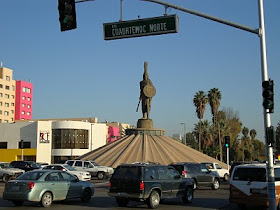 Tropical sunset
Tropical sunsetA world class cultural center with renowned paintings and sculpture. Diverse shopping, entertainment and exceptional dining along palm lined avenues. A growing, avante garde artistic community. Warm winter weather and Pacific Ocean winds cooling sprawling beaches in summer.
I'm not talking about San Diego, California but rather its slandered sister city just south of the border.
I spent a week recently in Tijuana, Mexico, population around 2 million. It's the so-called nesting ground for narco-traffickers and their associated flotsam.
As a criminologist I was curious whether media and rival tourist promoters have been molding facts to sell papers or lure business away. As an urban planner I go to the "worst" areas, often discovering they aren't as they are seem.
News accounts on Tijuana portray a city of shoot-outs, kidnappings, and murder mayhem. No doubt there is truth to that. Sadly, our data-light and anecdote-heavy media tells us nothing about what's really going on. Has our info-tainment "news" bamboozled us and missed the full story?
One example: LA Times article
What I discovered is that Tijuana, like other parts of Mexico, has indeed suffered greatly over the past two years. After the 2004 million-person march in Mexico City protesting inaction, the government launched a military led crack-down on the drug cartels. In Tijuana a prominent arrest of a drug kingpin and his clan has left a criminal vacuum. Nature abhors a vacuum. Consequently, just like Vancouver, Canada, Tijuana is ground zero for a war between gangs.
That much we hear. What do we not hear?
 Visiting Santa at the cultural center
Visiting Santa at the cultural center Apparently crime doesn't prevent Christmas shopping at the mall
Apparently crime doesn't prevent Christmas shopping at the mallWe don't hear murder and robbery rates were in decline in Tijuana from 2000 to 2005 and that most shooting and murder is between rival drug cartels or against the security forces who attack them. We rarely hear about the lively and safe downtown, financial areas, or other low crime neighborhoods.
 Public art and sculpture
Public art and sculptureWe rarely hear from everyday citizens in Tijuana. Those I spoke to did not frequent the violent parts of town, such as the unregulated suburbs. Like savvy urban dwellers all around the world - and tourists who pay attention - they knew where not to go. It's no different for savvy urban dwellers in Detroit or Washington, DC outside the circle. In spite of a spike in recent violence this year, the average citizen lives free of debilitating fear and violence.
That is because in Tijuana, as everywhere, crime is unevenly distributed. And in Tijuana there are areas as safe as any American city.
Check out blogger Patrick Osio's take on the issue:
Patrick's blog
My favorite line from his blog:
"I began interviewing, not Mexican nationals but rather American, Canadian and other expatriates. Of the 22 interviews on camera we did, not one single person said they feared for their life. They all stressed that living there they knew the importance of not going to certain neighborhoods and they were not involved in drugs... They had not changed their schedules; they shopped, dined out, attended plays and movie houses, visited friends, all routines in what they consider their own paradise."
No doubt Tijuana has much poverty, immigrant squalor, drug crime and corrupt officials. So does New Orleans! But do tourists avoid the fabulous New Orleans French Quarter because of it? Not likely.
It is easy to be fooled into fear. Tijuana is a work-in-progress to be sure. But it is also experiencing a Renaissance unlike any other I've seen. It'll be fascinating to revisit it in years to come.
 Benches for people, not vandals
Benches for people, not vandals Securing the whole bike
Securing the whole bike


 Drug dealers in Jackson throw running shoes over power lines to advertise they are located nearby
Drug dealers in Jackson throw running shoes over power lines to advertise they are located nearby